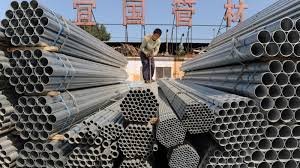Globaltraded.com — The global gas turbine market is witnessing intense competition as established players and emerging contenders vie for dominance. Leading companies such as Kawasaki Heavy Industries, Siemens, General Electric (GE), Mitsubishi Heavy Industries (MHPS), and Ansaldo Energy are at the forefront, continuously innovating to capture market share. This competition is driven by the increasing demand for efficient and reliable power generation solutions, as well as the shift towards cleaner energy sources.
Siemens, GE, and Mitsubishi Heavy Industries (MHPS) have long been the titans of the gas turbine industry. Siemens, renowned for its technological advancements, focuses on integrating digital solutions to enhance turbine efficiency and reliability. The company’s digital twin technology allows for predictive maintenance, reducing downtime and operational costs.
General Electric, with its deep-rooted expertise in power generation, leverages its extensive service network to offer comprehensive lifecycle management for its turbines. GE’s HA-class turbines are among the most efficient in the market, positioning the company as a leader in high-efficiency power generation.
Mitsubishi Heavy Industries, now part of Mitsubishi Hitachi Power Systems (MHPS), combines Japanese precision engineering with innovative technology. MHPS is known for its J-series gas turbines, which have set benchmarks for efficiency and operational flexibility.
Emerging Players and Niche Markets
While the giants dominate, companies like Ansaldo Energy, Harbin Electric, and OPRA Turbines are carving out their niches. Ansaldo Energy, an Italian powerhouse, focuses on heavy-duty gas turbines and has made significant inroads into the European and Middle Eastern markets. Harbin Electric, a major player in China, benefits from strong government backing and a booming domestic market.
OPRA Turbines, specializing in small-scale gas turbines, targets niche applications such as decentralized power generation and industrial cogeneration. Their compact and efficient turbines are ideal for remote locations and off-grid applications.
Regional Competitors and Specialized Suppliers
Companies like Solar Turbines, MAN Diesel, and Vericor Power cater to specific segments of the market. Solar Turbines, a subsidiary of Caterpillar, focuses on industrial gas turbines for oil and gas applications. Their turbines are known for their robustness and adaptability to harsh environments.
MAN Diesel & Turbo, part of the MAN Group, offers a range of gas turbines for marine and power generation applications. Their turbines are designed for high efficiency and low emissions, catering to the stringent regulations in the marine industry.
Vericor Power Systems, with its roots in aerospace technology, provides gas turbines for marine propulsion and power generation. Their turbines are lightweight and highly efficient, making them suitable for high-performance applications.
The gas turbine market is evolving rapidly, driven by several key trends. The shift towards renewable energy sources and the need for flexible, low-emission power generation solutions are shaping the future of the industry. Gas turbines, with their ability to quickly ramp up and down, are ideal for balancing intermittent renewable energy sources like wind and solar.
Technological advancements, particularly in materials science and digitalization, are enhancing turbine efficiency and reliability. The use of advanced alloys and coatings allows turbines to operate at higher temperatures, increasing efficiency. Digitalization, through the use of IoT and big data analytics, enables real-time monitoring and predictive maintenance, reducing operational costs and downtime.
The market dynamics vary significantly across regions. In North America and Europe, the focus is on upgrading and replacing aging infrastructure with more efficient and environmentally friendly solutions. In Asia, rapid industrialization and urbanization drive the demand for new power generation capacity.
China, with its ambitious energy targets, is a major growth market. Companies like Harbin Electric are well-positioned to capitalize on this demand, supported by favorable government policies and investment in infrastructure. In contrast, the Middle East is investing heavily in power generation to support its growing economies and reduce dependency on oil exports. This presents significant opportunities for companies like Siemens and MHPS, which have established strong footholds in the region.
Despite the growth prospects, the industry faces several challenges. Increasing competition, fluctuating commodity prices, and stringent environmental regulations put pressure on margins. Companies must continuously innovate and improve their offerings to stay competitive. The need for significant capital investment in research and development, coupled with the long lead times for large-scale projects, adds to the complexity.
The global gas turbine market is a dynamic and highly competitive arena. Leading companies like Siemens, GE, and MHPS dominate, but emerging players and specialized suppliers are making significant inroads. The market is driven by the need for efficient, reliable, and flexible power generation solutions, amid a global shift towards cleaner energy. As technological advancements and regional dynamics continue to shape the industry, companies must navigate a complex landscape to achieve sustained success.




























































